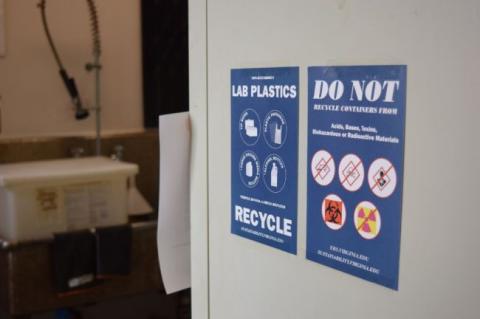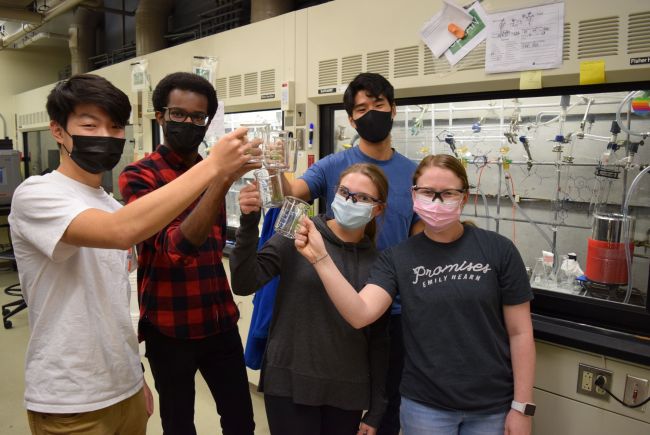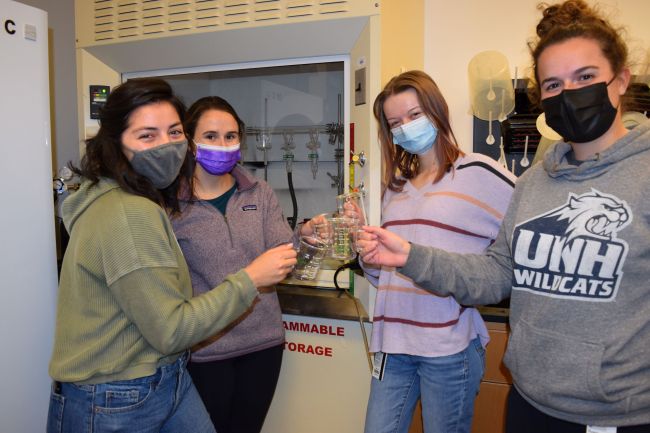
Researchers participating in the "Shut the Sash Challenge" saved an estimated $2,800 in energy costs in one month. The challenge is hosted by the Office for Sustainability to promote safe and sustainable fume hood management practices in labs across Grounds.
Congratulations to the Machan Lab and Griffen Lab, this year's winners of the "Shut the Sash Challenge" hosted by the Office for Sustainability.
Researchers at the Machan Lab in the Chemistry Department spend much of their time thinking about how to address the macro-problem of climate change, while over at the Griffin Lab in the Department of Biomedical Engineering, researchers are developing micro-materials to better heal wounds in the body.
From across that wide divide, though, both labs are taking action to improve safety and cut energy waste. Not only do they get to take pride in reducing their labs’ carbon footprint, the researchers in the Machan and Griffin labs received the coveted beaker mug prize.
Shut the Sash is an annual competition hosted by the UVA Office for Sustainability’s Green Labs program to promote safe and sustainable fume hood management practices in labs across Grounds. Sashes are the window-like barrier between researchers and the workspace within the fume hood. Keeping them shut ensures a safer workspace, and can drastically reduce a lab’s energy footprint.
If left open, a single fume hood can use as much energy as 3.5 average homes, so shutting them is a simple action that can make a big difference. Although labs account for about 9% of the University's physical footprint, they account for roughly 25% of the energy use -- a lot of that has to do with large equipment and specialized ventilation needs, and fume hoods relate to both.
Labs that participated in the Shut the Sash Challenge learned about the environmental impact and safety hazards associated with not shutting fume hood sashes and worked as teams to hold each other accountable and keep the sashes closed.
THE MACHAN RESEARCH GROUP
The Machan Research Group studies inorganic chemistry, but more specifically, they are creating solutions to address the challenges of climate change. A big part of their research explores how to sustainably convert carbon dioxide -- a major greenhouse gas -- to be utilized in large-scale industrial production of everyday things.
After learning about the benefits of proper fume hood management, especially the significant amount of energy fume hoods consume, the lab members now encourage one another to shut the sash whenever possible.
“It opened my eyes to how much our sashes are open -- it really adds up,” says Emma Cook, a graduate student in the lab. “It really became a group effort to keep them closed.”
Thanks to fume hood sash sensors, the Office for Sustainability was able to look at the average position of the sashes in the Machan lab month to month. At the beginning of the challenge, the sashes were 15-16% open and by the end, their average was less than 5%. This group did an excellent job keeping the sashes shut when they weren’t actively working in the fume hood.
Congratulations to the Machan Research Group! Visit their website to learn more about their work.
Thanks to fume hood sash sensors, the Office for Sustainability was able to look at the average position of the sashes in the Machan lab month to month. At the beginning of the challenge, the sashes were 15-16% open and by the end, their average was less than 5%. This group did an excellent job keeping the sashes shut when they weren’t actively working in the fume hood.
THE GRIFFIN LAB
The Griffin Lab in the Department of Biomedical Engineering researches ways to use injectable biomaterials in the body to promote tissue regeneration. The technology would help patients recover faster and more permanently from serious injuries.
Throughout October, PhD student Juliana Trujillo led the lab through a series of actions to promote responsible and sustainable fume hood management.
“It started with a deep clean of our hoods, which was needed,” she says. From there, she sent emails and posted stickers on the fume hoods reminding lab members to keep the sashes shut. Now, it’s standard practice in their lab and has changed how they think about space.
“Keeping the hoods down is a fairly easy process. So now we tend to keep the sashes down all the time. And we make sure they’re shut at the end of the day,” said Trujillo. They’ve been inspired to consider other sustainable practices, too, by working with the Green Labs program.
Not every lab at UVA has sash position sensors on their fume hoods, but we don’t let that stop them from competing. The Griffin Lab completed actions to promote good fume hood management, including sending encouraging reminders to others in the department, submitting photos of their safe and clean fume hood workspace, and learning more about the impact of shutting the sash. These actions support a culture of sustainability within labs, setting the example for other scientists.
Congratulations to the Griffin Lab! To learn more about their work, visit their website.
BIG ENERGY SAVINGS
Of the 21 labs that participated in the Shut the Sash Challenge, only four had sash position sensors. However, those labs had a total of 46 hoods and based on their reductions in their average sash positions, the Delta Force team in the Office for Sustainability was able to estimate that they saved $2,800 in energy costs in one month! Maintaining those behaviors could result in energy savings of over $34,000 annually.
If less than one fifth of the competing labs were able to have that significant impact, we can only guess at the total energy savings resulting from all 21 labs that competed in the Shut the Sash Challenge.
UVA Green Labs is grateful to everyone in the UVA research community advocating for safer, more environmentally sustainable laboratories.We’d like to recognize the other labs that participated here as well:
- Agaisse (Microbiology, Immunology, and Cancer Biology)
- Campbell (Biology)
- Civelek (Biomedical Engineering)
- Flood (Cytology)
- Goldfarb (Pathology)
- Gunnoe (Chemistry)
- HamRek (Microbiology, Immunology, and Cancer Biology)
- Hsu (Chemistry)
- Landers (Landers)
- Li (Orthopaedic Surgery)
- Lorenz (Microbiology, Immunology, and Cancer Biology)
- McGlathery (Environmental Science)
- McNamara (Medicine, Cardiovascular Division)
- Miller (Center for Public Health Genomics)
- Smith (Engineering Systems & Environment)
- Tamm (Molecular Physiology & Biological Physics)
- Wang (Biochemistry and Molecular Genetics)
- Zong (Microbiology)
The Green Labs Program hosts the Shut the Sash Challenge every October, and the Freezer Challenge in Spring, and engages with labs through the Green Lab Certification process. If you’re interested in learning more about the program, check out our website or email [email protected]. Additionally, you can find us every #LabTuesdays on the @sustainableuva Instagram and Facebook!



